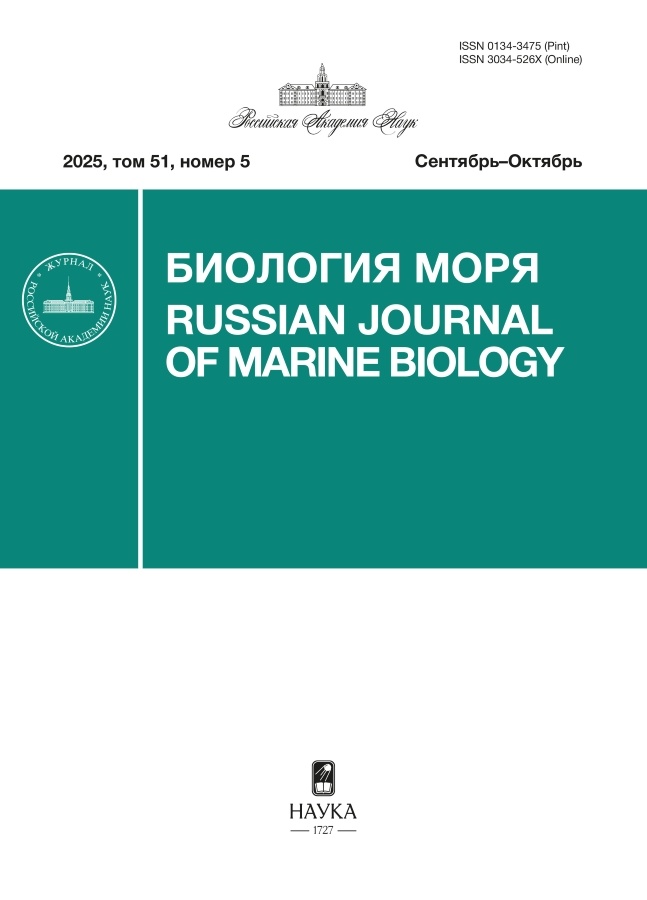Прижизненное генотипирование дальневосточного трепанга Apostichopus japonicus (Selenka, 1867) (Echinodermata: Holothuroidea) для аквакультурных и популяционно-генетических исследований
- Авторы: Ягодина В.Д.1,2, Брыков В.A.1
-
Учреждения:
- Национальный научный центр морской биологии им. А.В. Жирмунского (ННЦМБ) ДВО РАН
- Институт Мирового океана, Дальневосточный федеральный университет (ДВФУ)
- Выпуск: Том 51, № 5 (2025)
- Страницы: 262-267
- Раздел: ОРИГИНАЛЬНЫЕ СТАТЬИ
- Статья опубликована: 15.09.2025
- URL: https://journals.eco-vector.com/0134-3475/article/view/696603
- DOI: https://doi.org/10.31857/S0134347525050032
- ID: 696603
Цитировать
Полный текст
Аннотация
Проведена экстракция ДНК дальневосточного трепанга Apostichopus japonicus (Selenka, 1867) из амбулакральных ножек и из продольной мышцы тела (в качестве контроля). Выделенная из амбулакральных ножек ДНК оказалась высокого качества, с ней можно проводить дальнейшие молекулярно-генетические исследования. Возможность получать генетический материал из живой особи открывает новые перспективы для мониторинга популяций, возврата особей в среду, а также отбора гидробионтов с высоким полиморфизмом для разведения в условиях аквакультуры.
Ключевые слова
Об авторах
В. Д. Ягодина
Национальный научный центр морской биологии им. А.В. Жирмунского (ННЦМБ) ДВО РАН; Институт Мирового океана, Дальневосточный федеральный университет (ДВФУ)
Email: iagodinavd@gmail.com
Владивосток, 690041 Россия; Владивосток, 690022 Россия
В. A. Брыков
Национальный научный центр морской биологии им. А.В. Жирмунского (ННЦМБ) ДВО РАНВладивосток, 690041 Россия
Список литературы
- Гаврилова Г.С. Товарное выращивание дальневосточного трепанга. Владивосток: ТИНРО-центр. 2013. 99 с.
- Adachi K., Okumura S.I., Moriyama S. Genetic structure of Japanese sea cucumbers (Apostichopus japonicus) along the Sanriku coast supports the effect of earthquakes and related tsunamis // Genetica. 2018. V. 146. № 6. P. 497–503.
- Arafa S., Sadok S., El Abed A. Assessment of magnesium chloride as an anaesthetic for adult sea urchins (Paracentrotus lividus): incidence on mortality and spawning // Aquacult. Res. 2007. V. 38. P. 1673–1678.
- Chen L., Li Q., Yang J. Microsatellite genetic variation in wild and hatchery populations of the sea cucumber (Apostichopus japonicus Selenka) from northern China // Aquacult. Res. 2008. V. 39. P. 1541–1549.
- Chen M., Gao L., Zhang W. et al. Identification of forty-five gene-derived polymorphic microsatellite loci for the sea cucumber, Apostichopus japonicus // J. Genet. 2013. V. 92. P. e31–e35. http://www.ias.as.in/jgenet/OnlineResources/92/e31.pdf. https://doi.org/10.1007/s12041-013-0234-2
- Crespi-Abril A.C., Rubilar T. Ethical considerations for echinoderms: new initiatives in welfare // Animals (Basel). 2023. V. 13. Art. ID3377.
- Edgar R.C. MUSCLE: a multiple sequence alignment method with reduced time and space complexity // BMC Bioinform. 2004. V. 5. Art. ID113.
- Furlan E., Stoklosa J., Griffiths J. et al. Small population size and extremely low levels of genetic diversity in island populations of the platypus, Ornithorhynchus anatinus // Ecol. Evol. 2012. V. 2. № 4. P. 844–857.
- Kang J.-H., Kim Y.-K., Kim M.-J. et al. Genetic differentiation among populations and color variants of sea cucumbers (Stichopus japonicus) from Korea and China // Int. J. Biol. Sci. 2011. V. 7. № 3. P. 323–332.
- Kanno M., Li Q., Kijima A. Isolation and characterization of twenty microsatellite loci in Japanese sea cucumber (Stichopus japonicus) // Mar. Biotechnol. 2005. V. 7. P. 179–183.
- Liao M., Wang Y., Rong X. et al. Development of new microsatellite DNA markers from Apostichopus japonicus and their cross-species application in Parastichopus parvimensis and Pathallus mollis // Int. J. Mol. Sci. 2011. V. 12. P. 5862–5870.
- Madeira P., Stefanni S., Ávila S.P. Non-destructive tissue sampling and the use of PCR-RFLPs in two edible sea cucumbers from the north-eastern Atlantic, Holothuria mammata Grube, 1840 and H. sanctori Delle Chiaje, 1823 (Echinodermata: Holothuroidea) // Eur. Zool. J. 2018. V. 85. № 1. P. 89–94.
- Method for extracting DNA by echinoderm living body sampling. https://patents.google.com/patent/CN101168760A/en
- Nowland S.J., Jerry D.R., Southgate P.C. A non-destructive tissue sampling technique for holothurians to facilitate extraction of DNA for genetic analysis // Invertebr. Biol. 2015. V. 134. № 3. P. 252–259.
- Oh G.-W., Ko S.-C., Lee D.H. et al. Biological activities and biomedical potential of sea cucumber (Stichopus japonicus): a review // Fish. Aquat. Sci. 2017. V. 20. Art. ID28.
- Peakall R., Smouse P.E. GenAlEx 6.5: Genetic Analysis in Exel. Population genetic software for teaching and research – an update // Bioinformatics. 2012. V. 28. № 19. P. 2537–2539.
- Peng W., Bao Z.M., Du H.X. et al. Development and characterization of 70 novel microsatellite markers for the sea cucumber (Apostichopus japonicus) // Genet. Mol. Res. 2012. V. 11. № 1. P. 434–439.
- Rozas J., Ferrer-Mata A., Sánchez-DelBarrio J.C. et al. DnaSP 6: DNA Sequence Polymorphism analysis of large datasets // Mol. Biol. Evol. 2017. V. 34. № 12. P. 3299–3302.
- Shangguan J., Li Z. Development of novel microsatellite markers for Holothurian scabra (Holothuriidae), Apostichopus japonicus (Stichopodidae) and cross-species testing in other sea cucumbers // Chin. J. Oceanol. Limnol. 2018. V. 36. P. 519–527.
- Soliman T., Kanno M., Kijima A., Yamazaki Y. Population genetic structure and gene flow in the Japanese sea cucumber Apostichopus japonicus across Toyama Bay, Japan // Fish. Sci. 2012. V. 78. P. 775–783.
- Sulardiono B., Hartoko A., Aini A.N. et al. Genetic diversity of commercial sea cucumbers Stichopus (Echinoderm: Stichopodidae) based on DNA Barcoding in Karimunjawa, Indonesia // Biodiversitas. 2022. V. 23. № 2. P. 922–927.
- Tamura K., Stecher G., Kumar S. MEGA11: Molecular Evolutionary Genetics Analysis version 11 // Mol. Biol. Evol. 2021. V. 38. P. 3022–3027.
- Technelysium DNA Sequencing Software. South Brisbane, Australia. https://technelysium.com.au
- Wei J.-L., Cong J.-J., Sun Z.-H. et al. A rapid and reliable method for genetic sex identification in sea cucumber, Apostichopus japonicus // Aquaculture. 2021. V. 543. Art. ID737021.
- Yan J., Jing J., Mu X. et al. A genetic linkage map of the sea cucumber (Apostichopus japonicus) based on microsatellites and SNPs // Aquaculture. 2013. V. 404–405. P. 1–7.
Дополнительные файлы










